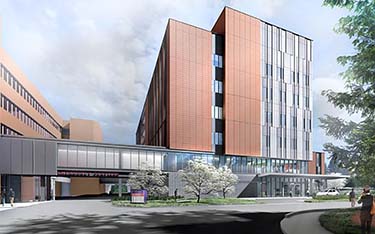|
Subscribe / Renew |
|
|
Contact Us |
|
| ► Subscribe to our Free Weekly Newsletter | |
| home | Welcome, sign in or click here to subscribe. | login |
Architecture & Engineering
| |
October 20, 2021
UW starts construction on $234M Northgate behavioral health facility
A/E Editor
Even before the pandemic and its toll on physical and mental well-being, attention was starting to be paid to the role that buildings and thoughtful/intentional design, especially in medical facilities, can play in promoting overall health. Last Friday ground was broken on a project that offers a new model for behavioral health facilities with an emphasis on architecture and design that promotes wellness and healing: the Behavioral Health Teaching Facility at the UW Medical Center Northwest campus.
The approximately 184,000-square-foot, six-story building will be a welcoming and healing space for individuals struggling with serious physical and behavioral health problems. It will be situated on a small footprint adjacent to the main hospital wing at 1550 N. 115th St. The building will also become the home for an interdisciplinary training and workforce development program focused on preparing and supporting the next generation of behavioral health providers for Washington state.
The project is being designed by SRG Partnership. The design vision is to create a setting that feels non-institutional. To promote a welcoming and safe environment, there will be a mix of public and private spaces, artwork by local artists, plenty of accessible outside space and design features that maximize access to daylight and views while assuring patient privacy, dignity and safety.
The top three floors of the facility will have flexible behavioral health inpatient units with standardized configurations designed to respond to a variety of client needs. These are designed with attached open-concept social and dining spaces to create a residential atmosphere that promotes serenity and comfort. Smaller, semiprivate adjacent spaces will provide areas of respite and quiet.
On floors two and three there will be medical and surgical beds to treat patients with acute or chronic medical problems, such as mental health or substance use disorders. The ground floor will have a public dining hall operated by campus food service for patients, staff and visitors, as well as conference rooms and state-of-the art neuromodulation services.
A soothing color scheme of sage and soft yellow will adorn common spaces. Artwork by Seattle-based visual artist Hernan Paganini will be featured in both public and patient spaces. Paganini's work is largely abstract and is inspired by ancient Egyptian relief sculpture. Initial designs for the behavioral health facility include faces and abstract shapes cast on a white background.
The building design also features several biophilic elements, a style which has been shown to increase well-being. The reception desk will be made to look like a felled tree trunk and outdoor benches will be fabricated from reclaimed trees.
The facility will have 150 beds in total. These will be dedicated to people experiencing mental health conditions who are civilly committed, older adults and those seeking voluntary treatment. Some of the beds will also be medical/surgical beds for those with mental health conditions who also require additional physical health treatment.
The goal is to create a space that is comfortable and calming for patients, students, and visitors that is a vast departure from the classic “walled off” style of behavioral health facilities that only add to the stigma of mental illness.
SRG design principals Pierce McVey and Carl Hampson are part of the team leading the project. In an interview with the DJC earlier this year, they spoke about new trends in the design of behavioral health projects.
“The goal is to design an environment for healing rather than housing,” McVey said. “Consequently, the design emphasizes creating places where people feel comfortable sending their loved ones for care and treatment — places with appropriate social density, ample daylighting, access to the outdoors and a variety of activities and therapy models.”
Speaking about this particular project, Hampson said, “Recognizing the innate connection between mind and body, the new building will provide beds and treatment spaces for patients suffering from both mental and physical health conditions. The importance of integrating this facility into the community and the benefits of destigmatizing mental health have been key drivers in the design.”
The approximate total cost of the project is $234 million. Construction is expected to finish in September 2023. Construction is by Clark|Abbott, a joint venture of general contractors Clark Construction Group and JR Abbott Construction. The integrated project delivery team also includes architect SRG Partnership and additional partners KPFF Consulting Engineers, Thornton Tomasetti, Ricca Design Studios, OJB Landscape Architecture, Mazzetti, PAE Engineers, McKinstry, VECA Electric, Schuff Steel, Performance Contracting, and Queen City.
Emma Hinchliffe can be
reached by email or by phone
at (206) 622-8272.



